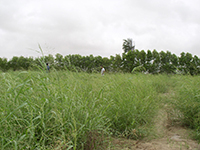Dec 15 2008
Take an arid field riddled with salty soil. Irrigate it with salty water. Plant a salt-tolerant grass along with a salt-sucking companion plant and what do you get? If you're a Brigham Young University research team, you raise a crop that successfully replaces corn as cattle feed.
 A BYU study found how to raise this grassy plant called Panicum in salty soil irrigated with salty soil. The resulting crop successfully replaced corn in cattle feed
A BYU study found how to raise this grassy plant called Panicum in salty soil irrigated with salty soil. The resulting crop successfully replaced corn in cattle feed
Their research highlights the promise of using salty water to turn the salty soil in the world's arid regions into sustainable agricultural land.
Just published online in the journal Agriculture, Ecosystems and Environment ahead of the February issue, the study identified a plant that could thrive in yet-unusable lands near the coasts in much of the world. But don't throw away your salt-shakers - the beef from the cattle raised on it tastes just the same as the meat you're used to.
"It seems odd that salty soil and salty water could produce useful crops, but that's what this study showed," said Brent Nielsen, chair of BYU's microbiology and molecular biology department and corresponding author on the study. "It's exciting to share in work that directly benefits people who need to find more land in order to produce the food and income they need to survive."
The research team focused on a plant called Panicum turgidum that can grow in salty conditions. They measured its protein content and determined that it could be a suitable alternative to existing cattle feed. Then they tested its growth potential when irrigated with the salty water found in the area. They showed that Panicum grew so fast it could be harvested almost monthly. Overall, with limited fertilizer, they produced 60,000 kilograms per hectare during the yearlong study. Nielsen is confident that further studies that determine the best ratios of fertilizer will boost that number over 100,000 kilograms.
The researchers also used nature to preserve a sustainable growing environment. Panicum is a "salt excluder," meaning it survives salty conditions by keeping salt out of its system, which most other plants can't do. Although this allows Panicum to grow on salty water, the extra salt deposited by irrigation would render the soil too salty for even this hardy plant. So the researchers found that planting a companion crop that is a "salt accumulator" prevented the soil from getting too salty. The other plant sucked up the extra salt, then was harvested and burned and the ashes turned into soap. After the yearlong study, the levels of salt in the soil were virtually unchanged.
The Balochistan region of southern Pakistan, where Nielsen's collaborators conducted the test, is one of the world's driest places, and the underground water supply is "brackish" or salty because of its proximity to the Indian Ocean.
There is a strong demand for fodder to feed the cattle that are a main source of income in the region, so a crop that can grow successfully in these conditions "would have enormous impact on the quality of life in local communities," said Ajmal Khan, a professor at the University of Karachi, director of the Pakistani research team and first author on the paper.
The Panicum was fed to cattle, and the cattle grew as big or bigger as those fed corn, with similar amounts of protein in their meat.
As world populations grow and agricultural land is threatened, this new approach can open up more crops for both livestock and humans, Nielsen said.
"By being able to transfer production of animal feed closer to the coasts, where you have these salty soils, more useful agricultural lands can be free for vegetable and grain production for human consumption," he said.
Now that Nielsen and his research colleagues have established that their approach works, they are taking a closer look at how the plant uses "tricks of nature" to survive a salty environment. Then the researchers want to explore breeding those traits into more traditional food crops. Another possibility is discovering the genes that help it tolerate salt and genetically engineering other plants to do the same.
Nielsen's collaboration with Khan and his other Pakistani colleagues grew out of Khan's multiple stints at BYU under the guidance of now-retired BYU scientist Darrell Weber. Khan, whose wife Bilquees Gul earned her Ph.D. at BYU and is also a coauthor on the study, said he hopes to "continue 23 years of very useful association with BYU."